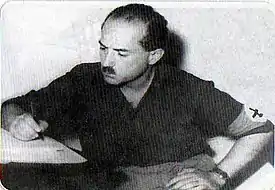Davud Monshizadeh | |
|---|---|
 | |
| Born | 28 August 1914 |
| Died | 13 July 1989 (aged 74) Uppsala, Sweden |
| Alma mater | Friedrich Wilhelm University |
| Political party | SUMKA |
| Military career | |
| Allegiance | |
| Service/ | |
| Battles/wars | |
| Parent |
|
Davud Monshizadeh (Persian: داوود منشیزاده; 28 August 1914 – 13 July 1989[1]) was the founder of SUMKA (the "Iranian National Socialist Workers Party") and a supporter of Nazism in Germany during World War II and in Iran after the war. He was also a scholar in Iranian Studies who later became a professor of Iranian Languages at Uppsala University, Sweden.
Career
Monshizadeh was born in Tehran, Iran. He is mainly remembered for his political life, most notably being the leader of SUMKA, but he is also recognized for his contributions to Iranian linguistics, particularly to the study of Modern and Middle Iranian languages.
Monshizadeh formed the SUMKA in 1951.[2] He had lived in Germany since 1937, and was a former SS member who fought and was wounded in the Battle of Berlin. During the war, he worked as a translator for interrogations with Soviet prisoners of war on the Eastern Front. Monshizadeh also wrote articles for Das Reich.[3] After the war, he was a professor at Ludwig Maximilians University of Munich and was deeply influenced by Jose Ortega y Gasset's philosophy, even translating many of his books (which he hoped would serve as founding principles for the party), from Spanish to Persian. He returned to Iran in 1950. Monshizadeh would later serve as a professor of Persian Studies at Uppsala University and Alexandria University. Monshizadeh was known as an admirer of Hitler and imitated many of the ways of the National Socialist German Workers Party (such as their militarism and salute), as well as attempting to approximate Hitler's physical appearance, including his moustache.
He is buried at Uppsala Old Cemetery, Sweden.
Chronology
- 1931 - Sent to France by Iranian government to study.
- 1937 - Moved to Germany, a year after the Hitler Cabinet declared Iranians to be "pure-blooded Aryans" and immune to all Nuremberg laws, thus making them capable of becoming Reich citizens.[4]
- 1938 - Began his studies in Nazi Germany. He studied with Walther Wüst, with whom he developed a close bond.[5]
- 1939 - Monshizadeh and Bahram Shahrokh (the future Iranian Propaganda Director) started working for the Persian program of the Third Reich’s Deutsche Radio.
- 1940 - He started writing articles for Das Reich, the official newspaper of the Nazi Party
- 1941 - He worked with various organizations in the Third Reich
- 1943 - Obtained his doctorate in philosophy and literature from Berlin University.[6]
- 1945 - During the Battle of Berlin, he fought as a member of the SS. He was injured and hospitalized (off and on) till 1947.
- 1947 - Taught Iranology and Persian language in University of Munich.
- 1950 - He returned to Iran.
- 1951 - Along with Manouchehr Amir Mokri and Hussein Zarabi, he established the Iranian National Socialist Party (Sumka),[6] which played a role against oil nationalization in Iran.
- 1953 - Monshizadeh was "Unofficially Exiled" to Europe by Shah Mohammad Reza Pahlavi.
- 1963 - He left Iran in 1963 and came to Sweden on the initiative of Professor Stig Wikander. He spent the rest of his life in Sweden teaching Iranology and Persian language at Uppsala University, eventually becoming Professor in Iranian Languages.
- 1989 - He died in Uppsala, Sweden, and is buried at Uppsala old cemetery (Uppsala gamla kyrkogård).
Works
- Das Persische im Codex Cumanicus, Uppsala: Studia Indoeuropaea Upsaliensia, 1969.
- Topographisch-historische Studien zum iranischen Nationalepos, Wiesbaden: Abhandlungen für die Kunde des Morgenlandes, 1975.
- Wörter aus Xurāsān und ihre Herkunft, Leiden: Acta Iranica; Troisième série, Textes et mémoires, 1990.
- Die Geschichte Zarēr's, ausführlich komment. von Davoud Monshi-Zadeh, Uppsala: Studia Indoeuropaea Upsaliensia, 1981.
- Ta'ziya : das persische Passionsspiel / mit teilweiser Übersetzung der von Litten gesammelten Stücke von Davoud Monchi-Zadeh, Stockholm: Skrifter utgivna av K. Humanistiska vetenskapssamfundet, 1967.
- Vihrūd va Arang : justārhā-yī dar jughrāfiy-̄yi asāṭīr ̄va tārīkh-̄i Īrān-i sharqī, pazhūhish-i Josef Markwart; tarjumah bā iz̤āfāt az Davūd Munshī-Zādah, Teheran: Majmūʻah-'i Intishārāt-i adabī va tārīkhī, 1989. (in Persian)
References
- ↑ https://www.bartarinha.ir/%D8%A8%D8%AE%D8%B4-%DA%86%D9%87%D8%B1%D9%87-%D9%87%D8%A7-17/988325-%D8%AF%D8%A7%D9%88%D9%88%D8%AF-%D9%85%D9%86%D8%B4%DB%8C-%D8%B2%D8%A7%D8%AF%D9%87-%D8%AA%D9%86%D9%87%D8%A7-%D8%A7%DB%8C%D8%B1%D8%A7%D9%86%DB%8C
- ↑ Dabashi, Hamid (2015). Persophilia: Persian Culture on the Global Scene. Harvard University Press. p. 106. ISBN 9780674504691.
- ↑ Christian Pahlavi, Pierre Pahlavi (2023), Le pont de la victoire – L'Iran dans la Seconde Guerre mondiale, Paris: Éditions Perrin, pp. 352 f. und Fußnote 37, ebd, ISBN 978-2-262-09919-0
- ↑ Asgharzadeh, Alireza (2007). "Iran and the Challenge of Diversity: Islamic Fundamentalism, Aryanist Racism, and Democratic Struggles". Palgrave Macmillan., p. 92.
- ↑ MONCHI-ZADEH, DAVOUD. Encyclopedia Iranica. Retrieved from: https://www.iranicaonline.org/articles/monchi-zadeh-davoud
- 1 2 Rahnema, Ali (November 2014). Behind the 1953 Coup in Iran: Thugs, Turncoats, Soldiers, and Spooks. Cambridge University Press. ISBN 9781107076068. Retrieved 5 March 2015.